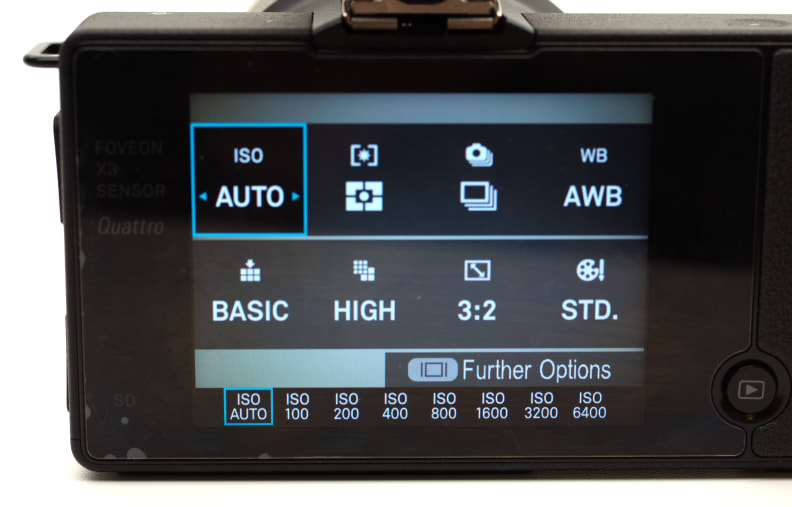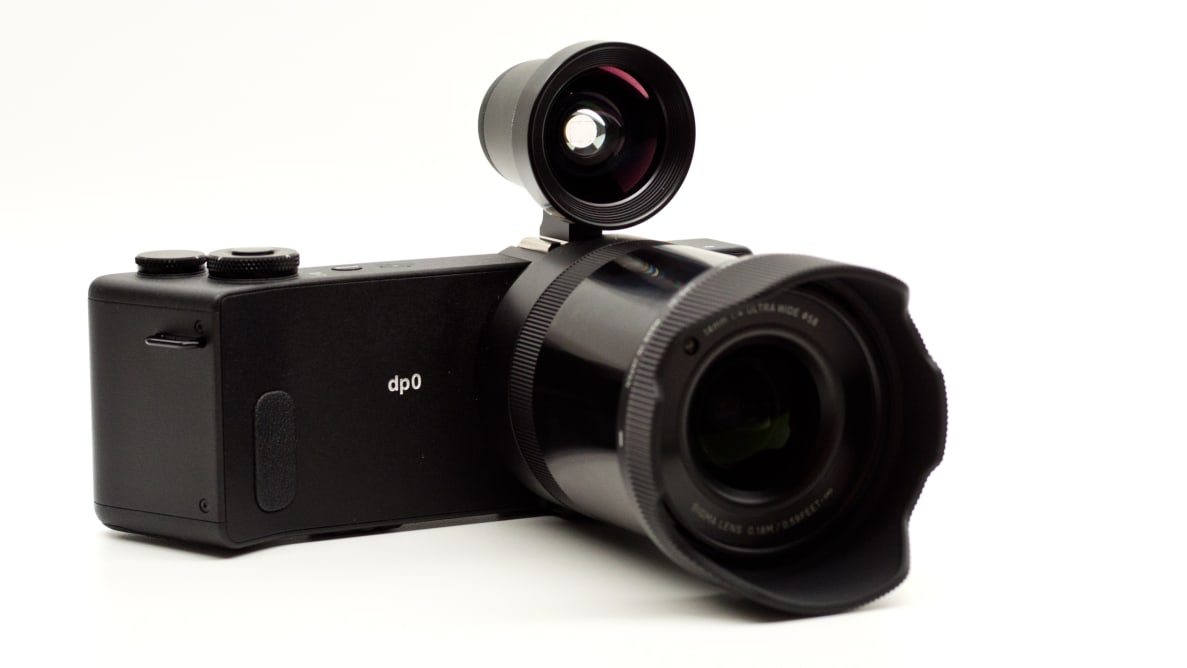Well, Sigma apparently isn't done with the Quattro experiment just yet, since it debuted the new dp0 Quattro (MSRP TBA) at the show. The newest addition to the family is mostly identical to those older models, with one big (and we do mean big) exception: a new, extra-bulky 14mm f/4 lens.
The super-wide focal length rounds out the Quattro family, joining the existing 19mm, 30mm, and 50mm options. But just how well does the Quattro blueprint hold up to such a large, wide lens? We went hands-on at CP+ to find out.
Video Hands-On
{{brightcove '4078581486001'}}
Design & Usability
Sigma continues to go its own way.
In the relatively conservative camera industry, "design innovation" usually means repositioning a dial, adding built-in WiFi, or giving an old model a new articulating screen. Even cameras renowned or reviled for their outside-the-box designs, like Pentax's divisive K-01, follow the general formula of a detachable lens and some sort of rectangular body.

The dp0 Quattro's unique grip provides excellent handling, even with the longer 14mm lens.
Sigma's Quattro lineup turns that convention on its head, with a long, boomerang-shaped body featuring a grip that's angled slightly back toward your hand. At first glance it feels like a perversion of nature, but once you hold the camera you discover that the ergonomics are actually quite pleasing—most of the time. Full credit to Sigma's designers for attempting to create a camera that puts function ahead of form.

The dp0 Quattro handles well, despite its awkward appearance.
As with the other dp-series cameras, the dp0 Quattro handles far better than you'd initially expect. The grip fills your hand, with dual control dials that snap confidently into position. The lens boasts a wide, smooth focus ring, and the "QS" quick menu gives you easy access to major shooting settings on the 3-inch, 922k-dot rear LCD. The menu is well laid out, and the entire camera feels much snappier than the sluggish Sigma DP Merrills that the Quattros replaced.
The most obvious design difference between the dp0 and the rest of the Quattro lineup is the 14mm lens. Despite its relatively narrow maximum aperture—at f/4, it's a full stop slower than the other dp Quattros—the lens itself is massive. It extends significantly further out from the body than the lenses on its stablemates, though it's light enough that the camera doesn't become unbalanced. If Sigma had opted for an f/2.8 design, it probably would have been a different story.

The 14mm lens provides a very useful wide angle of view, but it's not quite what we'd consider an "ultra wide."
As it is, the dp0 Quattro certainly won't slip into a small bag or jacket pocket, but then again neither would any of the Quattros. The biggest drawback of such a large lens is that it obstructs a good 25% of the view when using the optical viewfinder attachment. That's a shame, because the attachment is large and bright and one of the nicer accessories in the Quattro series.
{{ photo_gallery name="New Gallery" }}
Features
Quadrupling down on Foveon sensor tech
As with the other Quattro cameras, the dp0 uses Sigma's unique stacked Foveon sensor.
Unlike traditional Bayer sensors, Foveon chips have three complete sensor layers stacked on top of each other. This gives you a complete set of red, green, and blue color data at every pixel—no interpolation required. The "Quattro" Foveon sensors are so-called because their top blue layer has four times the resolution of the other two layers. The low-res red and green layers are used to balance color accuracy.

The quick menu system on the dp0 Quattro allows for near instant access to a number of key shooting settings.
This results in faster processing times, without losing any of the sharpness that older Sigmas produced with their Foveon X3 sensors. The dp0 Quattro is indeed much more agile than those earlier models, and the faster readout allows for both a usable 2–3fps burst rate and an improved 9-point contrast-detect autofocus system. Compared to market-leading DSLRs and mirrorless cameras that's nothing to crow about, but it's a huge improvement over previous Sigmas.
But speed isn't really the point with the dp0 Quattro. This combination of camera and lens wasn't meant to capture fast-moving subjects. Though the sensor has an ISO range of 100–6400, the f/4 maximum aperture makes it hard to push the shutter speed without winding up with an underexposed frame or a noisy final shot.

The dp0 Quattro uses SDHC memory cards, but also features a USB port.
You'll be far better off using the dp0 Quattro for slow-moving or static subjects—landscapes, architecture, and offbeat portraiture. Those subjets will get the most out of the sensor, which tops out at either 19 megapixels (in RAW) or 33 megapixels (in JPEG), depending on the aspect ratio you're using. Previous dp-series cameras have had impressive resolving capabilities when used properly (in good light, at base ISO, on a tripod), and there's no indication that this one will be any different.
Though our shooting on the show floor was limited, it would appear that the wide 21mm equivalent lens keeps distortion impressively in check, and the optics seem just as sharp—at least in the center—as the other Quattros. We'll have to wait to get a review copy into our labs to say any more than that.

The 14mm lens combined with the APS-C Foveon sensor makes for a 21mm equivalent focal length.
The most important thing for Sigma to focus on in future models is battery life. Though the dp-series cameras are (once again) better in this regard than the Merrills, they're still rated (likely overrated) at just 200 shots per charge. If you're going to pick up a Quattro, make sure you pick up an extra battery (or two, or quattro) to go along with it.
Conclusion
Keep Sigma weird.
You really have to hand it to Sigma: This is a company that knows how to turn heads.
From its critically acclaimed Art-series primes to the groundbreaking 18-35mm f/1.8 zoom, the company has been building a reputation for quality and value over the past few years. Of course, Sigma wouldn't be Sigma if it weren't also willing to stick its neck out on something completely off-the-wall at the same time.

The dp0 Quattro joins the existing dp1, dp2, and dp3 Quattro models, with a fixed 14mm lens.
The dp0 Quattro is exactly that sort of something—an endearingly oddball attempt to stand out from the crowd. Its weirdness is only enhanced by a range of bulky, quirky Quattro-series accessories, including an optical viewfinder and a magnifying loupe that turns the rear LCD into a (huge) electronic viewfinder. Attaching each new accessory just ups the dp0 Quattro's ridiculousness quotient; add them all and you've got yourself a mutant Franken-camera.

Optional attachments for the dp Quattro-series cameras only amplify its awkward looks. Just take a look at this loupe, which turns the rear LCD into a makeshift EVF.
On its own, though, the dp0 Quattro is a perfectly fine addition to a perfectly odd family. Compared to most new cameras here at CP+ it's slow, has iffy autofocus, sports an unwieldy lens, and suffers from horrid battery life. But it's pretty obvious Sigma isn't trying to compete with the wider camera world.
It's doing its own thing, letting its freak flag fly. The dp0 Quattro's certainly not a great camera for the average photographer, but it's daring to be different. There's no doubt it'll find a small, passionate cadre of dedicated fans.
Related Video
{{brightcove '3797455441001'}}
Meet the tester
TJ is the former Director of Content Development at Reviewed. He is a Massachusetts native and has covered electronics, cameras, TVs, smartphones, parenting, and more for Reviewed. He is from the self-styled "Cranberry Capitol of the World," which is, in fact, a real thing.
Checking our work.
Our team is here for one purpose: to help you buy the best stuff and love what you own. Our writers, editors, and lab technicians obsess over the products we cover to make sure you're confident and satisfied. Have a different opinion about something we recommend? Email us and we'll compare notes.
Shoot us an email


